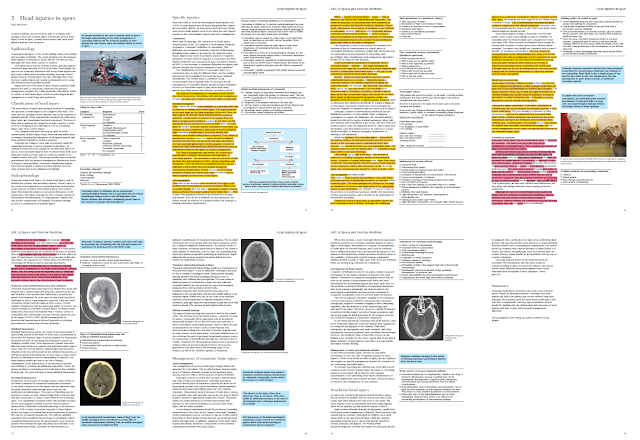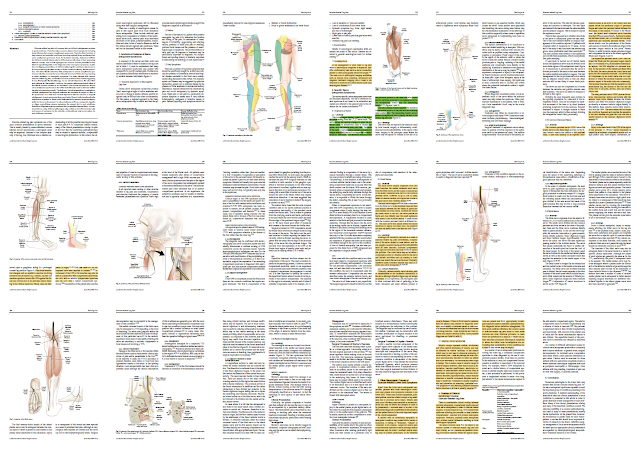In an earlier post I reported on a number of apparently plagiarised or self-plagiarised articles by Dr Paul McCrory. Since then there have been a number of developments in this story, which has attracted attention from media worldwide, especially in Australia, led by Melissa Davey of the Guardian, who has written about the present blog post here.
In this post I present 10 more examples of apparent text recycling by the same author. These are admittedly quite similar in style and content to the first set, but I felt that having done the work to identify these supplementary issues it was worthwhile documenting them. I feel that they demonstrate the scale of the problem: Dr McCrory has been churning out very similar stories (mostly about concussion in various sports) for 20 years, while—as far as I have been able to establish—performing very little original empirical or other research in that time.
Note that Exhibits 8, 9, and 10 include the apparent recycling of text from work that does not have Dr McCrory listed as an author (i.e., apparent plagiarism-proper rather than self-plagiarism). I omitted the case of a chapter in a book (B) that contained many paragraphs of recycled text from a chapter by Dr McCrory in an earlier book (A), because in book B he is only listed as a contributor at the start of the book (i.e., his name does not appear directly on the chapter in question).
There are probably still a few more cases to be uncovered, but it can be laborious work, especially when the only source of a document is the Google Books preview.
Finally, as a "bonus", and to show just how big a problem plagiarism is in science and academia more generally, I've included a case where Dr McCrory's work was apparently plagiarised by other authors.
Exhibit 1
McCrory, P. (2005). Does second impact syndrome exist? Clinical Journal of Sports Medicine, 11(3), 144–149. https://doi.org/10.1097/00042752-200107000-00004
About 60% of this article appears to have been copied, verbatim and without appropriate attribution, from:
- McCrory, P. R., & Berkovic, S. F. (1998). Second impact syndrome. Neurology, 50(3), 677–683. https://doi.org/10.1212/WNL.50.3.677
The copied text is highlighted in blue here:
Exhibit 2
McCrory, P., le Roux, P. D., Turner, M., Kirkeby, I. R., & Johnston, K. M. (2012). Rehabilitation of acute head and facial injuries. In R. Bahr (Ed.), The IOC manual of sports injuries (pp. 95–100). Wiley.
About 70% of this chapter appears to have been copied, verbatim and without appropriate attribution, from the following sources:
- Yellow: McCrory, P., & Rise, I. R. (2004). Head and face. In R. Bahr & S. Maehlum (Eds.), Clinical guide to sports injuries (pp. 55–90). Human Kinetics. https://books.google.com/books?id=mmRnr0x0p4QC
- Blue: McCrory, P. (2007). Who should retire after repeated concussions? In D. MacAuley & T. M. Best (Eds.), Evidence-based sports medicine (2nd ed., pp. 93–107). Blackwell.
- Green: McCrory, P., Meeuwisse, W., Johnston, K., Dvorak, J., Aubry, M., Molloy, M., & Cantu, R. (2009). Consensus statement on concussion in sport: The 3rd international conference on concussion in sport held in Zurich, November 2008. Journal of Athletic Training, 44(4), 434–448. https://doi.org/10.4085/1062-6050-44.4.434
Exhibit 3
McCrory, P. (2007). Who should retire after repeated concussions? In D. MacAuley & T. M. Best (Eds.), Evidence-based sports medicine (2nd ed., pp. 93–107). Blackwell.
About 35% of this chapter (which appeared as a source text in the previous exhibit) appears to have been copied, verbatim and without appropriate attribution, from the following sources:
- Yellow: McCrory, P. (2002). Treatment of recurrent concussion. Current Sports Medicine Reports, 1(1), 28–32. https://doi.org/10.1249/00149619-200202000-00006
- Blue: McCrory, P. (2001). When to retire after concussion? British Journal of Sports Medicine, 35(6), 380–382.
- Pink: McCrory, P. (2002). Boxing and the brain. British Journal of Sports Medicine, 36(1), 2.
- Green: McCrory, P., Johnston, K., Meeuwisse, W., Aubry, M., Cantu, R., Dvorak, J., T Graf-Baumann, T., Kelly, J., Lovell, M., & Schamasch, P. (2005). Summary and agreement statement of the 2nd International Conference on Concussion in Sport, Prague 2004. British Journal of Sports Medicine, 39(4), 196–204. https://doi.org/10.1136/bjsm.2005.018614
Exhibit 4
McCrory, P. (2002). Treatment of recurrent concussion. Current Sports Medicine Reports, 1(1), 28–32. https://doi.org/10.1249/00149619-200202000-00006
About 40% of this article (which appeared as a source text in the previous exhibit) appears to have been copied, verbatim and without appropriate attribution, from the following sources (which also appeared as source texts in the previous exhibit):
- Yellow: McCrory, P. (2001). When to retire after concussion? British Journal of Sports Medicine, 35(6), 380–382.
- Blue: McCrory, P. (2002). Boxing and the brain. British Journal of Sports Medicine, 36(1), 2.
- Pink: McCrory, P., Johnston, K. M., Mohtadi, N. G., & Meeuwisse, W. (2001). Evidence-based review of sport-related concussion: Basic science. Clinical Journal of Sport Medicine, 11(3), 160–165. https://doi.org/10.1097/00042752-200107000-00006
Exhibit 5
McCrory, P. (2001). The “piriformis syndrome”—myth or reality? British Journal of Sports Medicine, 35(4), 209–211. https://doi.org/10.1136/bjsm.35.4.209-a
About 90% of this editorial appears to have been copied, verbatim and without appropriate attribution, from:
- McCrory, P., & Bell, S. (1999). Nerve entrapment syndromes as a cause of pain in the hip, groin and buttock. Sports Medicine, 27(4), 261–274. https://doi.org/10.2165/00007256-199927040-00005
Exhibit 6
McCrory, P. (2002). What advice should we give to athletes postconcussion? British Journal of Sports Medicine, 36(5), 316–318. https://doi.org/10.1136/bjsm.36.5.316
About 50% of this article appears to have been copied, verbatim and without appropriate attribution, from:
- McCrory, P. (1997). Were you knocked out? A team physician's approach to initial concussion management. Medicine & Science in Sports & Exercise, 29(7 suppl.), S207–212. https://doi.org/10.1097/00005768-199707001-00002
Exhibit 7
McCrory, P. (2005). Head injuries in sport. In G. Whyte, M. Harries, & C. Williams (Eds.), SABC of Sports and Exercise Medicine (3rd ed., pp. 8–15). Blackwell.
About 30% of the main text of this chapter (which is not the same as the 2015 chapter "Head injuries in sports", which was discussed in my earlier blog post) appears to have been copied, verbatim and without appropriate attribution, from the following sources:
- Yellow: McCrory, P. (1997). Were you knocked out? A team physician's approach to initial concussion management. Medicine & Science in Sports & Exercise, 29(7 suppl.), S207–212. https://doi.org/10.1097/00005768-199707001-00002
- Pink: Aubry, M., Cantu, R., Dvorak, J., T Graf-Baumann, T., Johnston, K., Kelly, J., Lovell, M., McCrory, P., Meeuwisse, W., & Schamasch, P. (2005). Summary and agreement statement of the first International Conference on Concussion in Sport, Vienna 2001. British Journal of Sports Medicine, 36(1), 6–10. https://doi.org/10.1136/bjsm.36.1.6
Exhibit 8
McCrory, P., Davis, G., & Makdissi, M. (2012). Second impact syndrome or cerebral swelling after sporting head injury. Current Sports Medicine Reports, 11(1), 21–23. https://doi.org/10.1249/JSR.0b013e3182423bfd
About 35% of this article appears to have been copied, verbatim and without appropriate attribution, from the following sources:
- Yellow: McCrory, P. (2005). Does second impact syndrome exist? Clinical Journal of Sports Medicine, 11(3), 144–149. https://doi.org/10.1097/00042752-200107000-00004
- Blue: Randolph, C., & Kirkwood, M. W. (2009). What are the real risks of sport-related concussion, and are they modifiable? Journal of the International Neuropsychological Society, 15(4), 512–520. https://doi.org/10.1017/S135561770909064X
- Green: Davis, G. A. (2012). Neurological outcomes. In M. W. Kirkwood & K. O. Yeates (Eds.), Mild traumatic brain injury in children and adolescents: From basic science to clinical management (pp. 99–122). Guilford Press.
Exhibit 9
McCrory, P. (2018). Concussion revisited: A historical perspective. In I. Gagnon & A. Ptito (Eds.), Sports concussions: A complete guide to recovery and management (pp. 9–24). CRC Press.
About 15% of this chapter appears to have been copied, verbatim and without appropriate attribution, from the following sources:
- Yellow: McCrory, P., Feddermann-Demont, N., Dvořák, J., Cassidy, J. D., McIntosh, A., Vos, P. E., Echemendia, R. J., Meeuwisse, W., & Tarnutzer, A. A. (2017). What is the definition of sports-related concussion: A systematic review. British Journal of Sports Medicine, 51(11):877–887. https://doi.org/10.1136/bjsports-2016-097393
- Blue: Zezima, K. (2014, May 29). How Teddy Roosevelt helped save football. The Washington Post. https://www.washingtonpost.com/news/the-fix/wp/2014/05/29/teddy-roosevelt-helped-save-football-with-a-white-house-meeting-in-1905/
- Pink: Johnston, K. M., McCrory, P., Mohtadi, N. G., & Meeuwisse, W. (2001). Evidence-based review of sport-related concussion: Clinical science. Clinical Journal of Sports Medicine, 11(3), 150–159. https://doi.org/10.1097/00042752-200107000-00005
Exhibit 10
McCrory, P., Bell, S., & Bradshaw, C. (2002). Nerve entrapments of the lower leg, ankle and foot in sport. Sports Medicine, 32(6), 371–391. https://doi.org/10.2165/00007256-200232060-00003
About 20% of the text of this article appears to have been copied, verbatim and without appropriate attribution, from the following sources:
- Yellow: McCrory, P. (2000). Exercise-related leg pain: Neurological perspective. Medicine & Science in Sports & Exercise, 32(3 suppl.), S11–14. https://doi.org/10.1097/00005768-200003001-00003
- Green: Pecina, M. M., Markiewitz, A. D., & Krmpotic-Nemanic, J. (2001). Tunnel syndromes (3rd ed.). See Chapter 44, p. 229.
Bonus Exhibit: The biter bit?
Espinosa, N., Jr. & Klammer, G. (2018). Peripheral nerve entrapment around the foot and ankle. In M. D. Miller & S. R. Thompson (Eds.), DeLee & Drez's orthopaedic sports medicine (5th ed., pp. 1402–1420). Elsevier Health Sciences.
The highlighted sentences of this chapter appear to have been copied, verbatim and without appropriate attribution, from Exhibit 10:
- McCrory, P., Bell, S., & Bradshaw, C. (2002). Nerve entrapments of the lower leg, ankle and foot in sport. Sports Medicine, 32(6), 371–391. https://doi.org/10.2165/00007256-200232060-00003






















